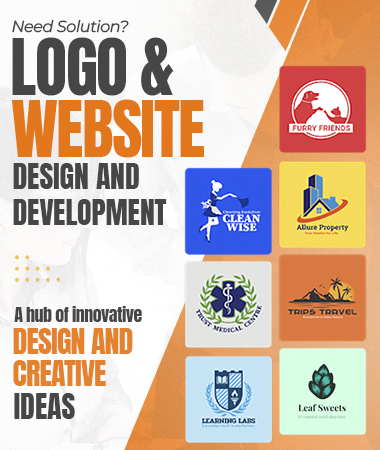File Format and Usage Guidelines Assistance for Logo Design
Creating a custom logo design is a crucial step in establishing a brand's identity. A well-designed logo not only represents the essence of a brand but also communicates its values and personality to the audience. However, the journey of best logo design help doesn't end with the creation of the logo itself; it extends to ensuring that the logo is usable across various platforms and mediums. This is where understanding file formats and usage guidelines becomes essential.
When it comes to logo design, buy logo design service for the file formats play a significant role in ensuring versatility and adaptability across different applications. Here are some commonly used file formats in logo design:
Vector formats are preferred for logos because they are resolution-independent, meaning they can be scaled to any size without losing quality. Adobe Illustrator (AI) and Encapsulated PostScript (EPS) are logo design service popular choices for creating vector-based logos. Scalable Vector Graphics (SVG) is another format gaining traction due to its compatibility with web applications.
IRaster formats are composed of pixels and are suitable for photographic images but are not ideal for logos. However, PNG (Portable Network Graphics) is commonly used for logos that require transparency. JPEG (Joint Photographic Experts Group) is not recommended for logos due to its lossy compression, which can degrade image quality.
Portable Document Format (PDF) is versatile and widely supported across different platforms. It preserves vector graphics and is suitable for printing high-quality logos. You can opt for an affordable logo design help to guide you.
Fonts used in unique logo design should be provided in OpenType (OTF) or TrueType (TTF) formats to ensure compatibility across various operating systems and software.
In addition to providing logos in the appropriate file formats, it's essential to establish clear usage guidelines to maintain consistency and integrity across all brand identity design representations. Here are some key aspects to consider:
Define the minimum clear space around the logo to ensure that it remains visually distinct and uncluttered. This space should be free from any other graphic elements or text.
Specify the minimum and maximum sizes when you select a cheap logo design deal at which the logo should be displayed to maintain legibility and visual impact across different mediums.
Provide guidelines for both color and monochrome versions of the logo. Specify primary and secondary color palettes, as well as acceptable grayscale or black-and-white variations for situations where color reproduction is limited.
Ensure that the logo is always aligned correctly and maintains its proportions. Guidelines for horizontal and vertical variations of the logo should be provided to accommodate different layout requirements.
Define whether the logo should be used on a solid background or if it is permissible to place it on an image or patterned background. Provide instructions for maintaining contrast and readability in various background scenarios.
Clearly outline any restrictions on logo usage, such as unauthorized alterations, distortions, or manipulations. This helps protect the integrity of the brand identity and ensures consistent representation across all touchpoints.
For designers and businesses embarking on the logo design journey, understanding file formats and usage guidelines can be daunting. However, several resources and tools are available to provide assistance:
There are numerous online guides and tutorials available that explain file formats and provide best practices for logo usage. Websites like Adobe's Creative Cloud Learn offer comprehensive resources for logo design and branding.
Design software platforms like Adobe Illustrator offer extensive support for exporting logos in various file formats. Users can access built-in templates and presets to streamline the process.
Many established brands publish comprehensive brand identity guidelines that include detailed instructions for logo usage. Studying these guidelines can provide valuable insights into industry best practices.
For businesses seeking expert assistance, hiring a professional graphic designer or design agency can ensure that logos are created and delivered according to industry standards. These professionals can also provide guidance on logo usage and branding strategies.
Related Blogs
- Web Design Accessibility: Ensuring Inclusivity for All Users
- How to Create a WordPress Website?
- How to Use Google Analytics for Digital Marketing?
- How to Deal with Platform Compatibility Challenges in the Website Design Process
- Process of Metaverse Website Development?
- Tips to Integrate Data Science in Website Development
- Importance of URL in a Website Design
- How to Include Cultural Sensitivity in Website Design
- Tips for Keeping Backups in Website Development
- Remarketing Advertising Trends in 2024
- Four Pillars of Website Development and Tricks to Apply It
- Importance of Scriptwriting in Social Media Digital Marketing
- How to Create Graphic Design for a Packaging Material of a Brand
- How to Conduct SERP Analytics and Tracking in Digital Marketing
- How to Differentiate a Logo Designed for Video Game?
- Tips to Develop Angular JS Website Development
- Integration of Scroll-triggered Animations in Website Design
- Describe What Is Microsoft SharePoint and Its Importance for Website Development
- Tips to Download Resources (Webpage, Files, Videos) From A Website
- Suggest Importance of Bootstrap Process in Website Development
- How to Implement Web Design in Semplice Site Builder?
- Guide How to Design Content for Digital Marketing Newsletter
- How to Develop Website Based On PSSE UEL Model?
- File Format and Usage Guidelines Assistance for Logo Design
- Tips to Future Proof Website Development Process using New Technologies
- How to Use Mailchimp for Custom Digital Marketing Campaigns
- Understanding Custom Experimental Navigation in Website Design
- Importance of Domain Name in Website Development
- Introduction to Deeply Nested Schemas in Digital Marketing



